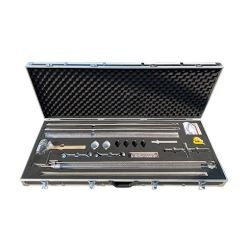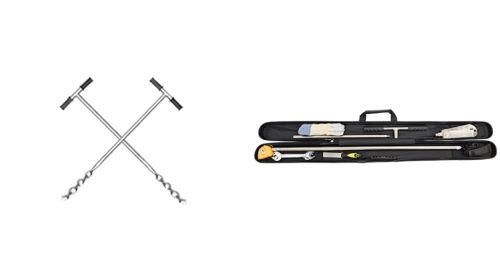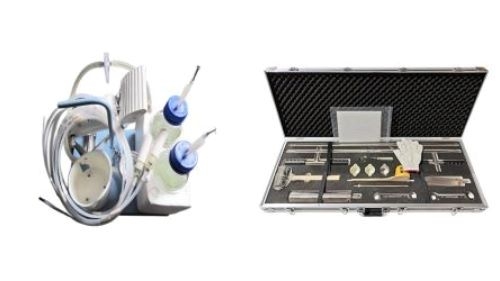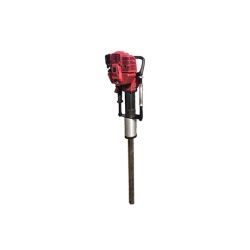Soil sampling is the backbone of data-driven decisions in agriculture, environmental science, geotechnical engineering, and beyond. Whether you’re assessing soil fertility for crops, monitoring contamination, or testing soil stability for construction, the right soil sampler ensures accurate, representative samples—critical for reliable laboratory analysis. With a range of tools designed for specific soil types, depths, and goals, understanding the main types of soil samplers is key to matching the tool to your project. This blog breaks down the primary soil sampler types, their unique features, and their key applications to simplify your selection process.
Main Types of Soil Samplers
Each type of soil sampler is engineered to address distinct challenges, such as preserving soil layer structure, handling hard or loose soil, or enabling deep sampling. Below are the most common and practical types, including professional-grade options from SISCO, tailored to diverse project needs:
1. Core Samplers: Preserving Vertical Soil Structure
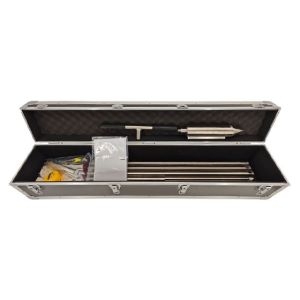
Core samplers are purpose-built to extract cylindrical, undisturbed soil samples, making them essential for analyzing how soil prope
rties (like contaminants, nutrients, or moisture) vary with depth. Their rotating and sealing drill body design ensures direct extraction from specific depths without disrupting upper soil layers—ideal for loose or sensitive soils (e.g., sediment, marsh, or mud-carbon soil) where borehole collapse is a risk.
- Key Feature: Maintains the natural vertical structure of soil, critical for layer-specific analysis.
- Example Product: SISCO-SS-JC0203 Soil Core Sampler Kit, designed for efficient deep sampling while keeping samples intact.
- Ideal For: Environmental contamination surveys, soil fertility mapping, or wetland ecosystem studies where preserving layer integrity is non-negotiable.
2. Auger Samplers: Efficient Drilling for Deep or Hard Soil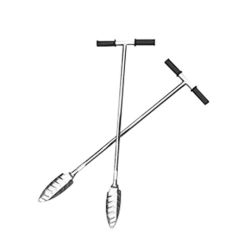
Auger samplers feature a rotating cutting edge (often spiral or heart-shaped) that drills into soil, making them perfect for deeper sampling or harder soil conditions (e.g., clay, compacted earth). Many include a T-handle for easy manual operation, reducing effort while minimizing disturbance to the soil structure—ensuring samples remain representative of the in-situ soil.
- Key Feature: Balances depth capability with ease of use, suitable for frequent sampling across large areas.
- Example Product: SISCO-SS-JC802A Soil Auger Sampler With T Handle, a staple for agricultural research and routine soil testing.
- Ideal For: Agricultural projects (e.g., testing nutrient levels for crop rotation), geotechnical surveys, or backyard gardening where deeper samples are needed without heavy equipment.
3. Electric Soil Samplers: Streamlining Labor-Intensive Work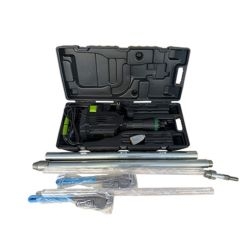
Electric soil samplers leverage high-torque electric motors to eliminate manual digging, drastically reducing labor intensity and boosting sampling efficiency. As professional-grade tools, they deliver consistent results across repeated use—making them ideal for large-scale projects where speed and uniformity are priorities.
- Key Feature: Automates the sampling process, cutting down on time and physical effort compared to manual tools.
- Example Product: SISCO-SS-JCRTTC20 Electric Soil Sampler Kit, built for agriculture, environmental research, and geotechnical applications.
- Ideal For: Commercial farm soil mapping, regional environmental monitoring, or construction site testing where dozens of samples need to be collected quickly.
4. Piston Soil Samplers: Ensuring Sample Originality
Piston-driven samplers use a piston mechanism to extract soil, which significantly reduces disturbance during collection. This design preserves the original composition, texture, and moisture content of the sample—critical for sensitive analyses like contaminant detection, soil biology studies, or regulatory compliance reporting.
- Key Feature: Minimizes sample alteration, ensuring data reflects real-world soil conditions.
- Example Product: SISCO-SS-JC801A Piston Soil Sampler Kit, widely used in environmental surveys and geological exploration.
- Ideal For: Scientific research (e.g., studying soil microorganisms), industrial site pollution assessments, or landfill leachate impact studies where sample purity is essential.
5. Stainless Steel Samplers: Durability for Harsh Conditions
Stainless steel samplers—including core kits and probe drills—are crafted from corrosion-resistant stainless steel, making them durable even in harsh field conditions (e.g., wet soil, chemical exposure, or frequent outdoor use). Many feature a split design, allowing for quick on-site sample observation and processing without compromising sample integrity.
- Key Feature: Resists rust and wear, ensuring long-term reliability in challenging environments.
- Example Products:
SISCO-SS-JC803A Stainless Steel Core Soil Sampling Kit (for geological exploration and soil testing).
SISCO-SS-JC802C Stainless Steel Soil Probe Drill (for precise agricultural and environmental sampling). - Ideal For: Coastal soil testing, industrial site surveys, or long-term monitoring projects where tools need to withstand harsh elements.
6. Specialized Samplers: Targeting Niche Sampling Goals
Some samplers are engineered for unique, specific tasks that standard tools can’t address. Two critical examples are:
- Soil Solution Samplers: Designed for in-situ extraction of soil pore water or soil solution, enabling accurate chemical and nutrient analysis. The SISCO-SS-JCTRSW Soil Sampler for Solution Sampling collects uncontaminated samples at various depths, making it ideal for studying nutrient cycles or pollutant movement in soil.
- Heavy Metal Samplers: Tools like the SISCO-SS-JC803D Sampler Machine for Soil Heavy Metals Kit are tailored to collect samples for heavy metal testing—essential for environmental remediation, industrial site cleanup, or regulatory compliance in areas with potential metal contamination.
7. Soil Drilling Machines: Accessible Deep Sampling for All Users
Soil drilling machines are lightweight, handheld rigs inspired by larger hydraulic, gasoline, or pneumatic drills—yet designed for ease of use, even for
inexperienced operators. They require no water during drilling, ensuring samples stay unpolluted and undisturbed, and can be operated by 1–2 people with minimal training.
- Key Feature: Makes deep sampling accessible without specialized expertise or heavy equipment.
- Example Product: SISCO-SS-JCTQZ Soil Drilling Machine for Sampling, built for simplicity and reliability.
- Ideal For: Geological exploration, deep environmental surveys, or rural projects where access to large drilling rigs is limited.
Key Applications of Soil Samplers
While the focus is on sampler types, understanding their real-world uses helps contextualize why each design matters. Below are the most impactful applications across industries:
1. Agriculture: Optimizing Crop Health and Yield
In agriculture, soil samplers assess soil fertility, nutrient levels (nitrogen, phosphorus, potassium), pH, and moisture content—data that guides precision farming practices. This includes:
Tailoring fertilizer use to avoid waste and reduce costs.
Planning crop rotation to match crops to soil conditions (e.g., legumes for nitrogen-poor soil).
Managing irrigation to prevent over or under-watering.
Example: A farmer uses the SISCO-SS-JC802A Auger Sampler to test soil at 6–12 inch depths, ensuring wheat crops receive the right nutrients for root development and yield.
2. Environmental Science: Monitoring Contamination and Remediation
Environmental scientists rely on soil samplers to track contaminants (heavy metals, pesticides, volatile organic compounds) and measure the success of cleanup efforts. Common uses include:
Assessing pollution at former industrial sites or landfills.
Monitoring how contaminants spread through soil over time.
Verifying that remediation projects (e.g., soil excavation, chemical treatment) meet regulatory standards.
Example: A team uses the SISCO-SS-JC801A Piston Sampler to collect undisturbed samples near a mining site, checking if heavy metals have seeped into deep soil layers.
3. Geotechnical Engineering: Ensuring Safe Construction
Geotechnical engineers use soil samplers to analyze soil stability, compaction, and load-bearing capacity—critical for building safe infrastructure. Applications include:
Testing soil for roads, bridges, and buildings to prevent foundation failure.
Assessing soil conditions for tunnels, pipelines, or dams.
Planning slope stabilization to avoid landslides in hilly areas.
Example: An engineer uses the SISCO-SS-JCTQZ Soil Drilling Machine to collect 10-foot-deep samples for a new school, ensuring the soil can support the building’s weight.
4. Gardening and Landscaping: Tailoring Soil to Plants
Home gardeners and landscapers use compact samplers (like the SISCO-SS-JC802C Stainless Steel Soil Probe Drill) to test soil texture (sandy, clay, loam) and nutrient needs. This helps:
Choose plants that thrive in existing soil conditions (e.g., succulents for sandy soil).
Add amendments (compost, lime) to improve drainage or adjust pH.
Determine optimal planting depths (e.g., shallow for annual flowers, deeper for perennials).
Conclusion
The right soil sampler is more than just a tool—it’s a gateway to accurate, actionable data that shapes success across agriculture, environmental science, engineering, and gardening. Each type, from manual augers to specialized heavy metal samplers, is crafted to solve specific challenges, whether that’s preserving soil layers, handling harsh conditions, or streamlining large-scale sampling. At siso.com, our soil samplers are designed to meet the unique demands of these applications—from lightweight manual tools for small-scale projects to heavy-duty electric kits for large operations. By understanding the type of sampler that aligns with your soil, depth, and analysis needs, you’ll ensure accurate data that drives better outcomes, whether you’re boosting crop yields, cleaning up contaminated sites, or building safe infrastructure. With the right sampler in hand, you can turn soil samples into confident decisions that stand the test of time.

